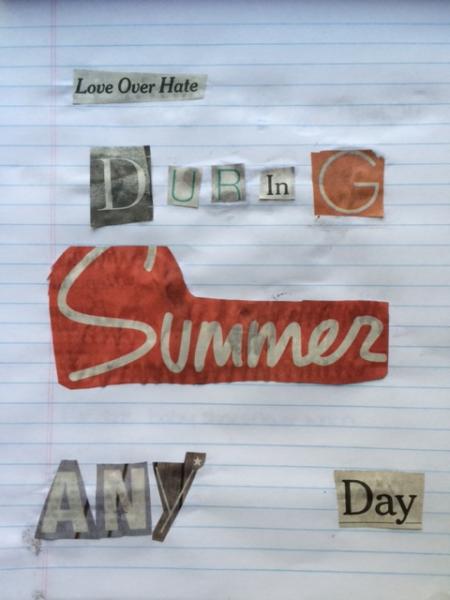De grandes rencontres aux petits sommets de l’enfance et l’adolescence
Submitted by admin on
Une équipe de Trickster, composée de Bruno et Jani, est au Lac Simon depuis presque deux semaines, afin de rencontrer les jeunes de l’école Amik-Wiche et construire avec eux une présentation artistique basée sur un conte partagé par Virginia Dumont . Les jeunes artistes présenteront le tout ce mardi, à la salle communautaire, deux fois plutôt qu’une.
Lac Simon ! Lac Simon ! Lac Simon ! Comment écrire un article comme les autres quand pour la quatrième fois en 3 ans tu m’accueilles encore avec autant de chaleur et de surprises ?
La magie ne fait que se multiplier à chaque fois et le projet devient de plus en plus petit prétexte de grandes rencontres. Il va s’en dire que je peux vous partager qu’une magnifique équipe de jeunes participants de 10 à 15 ans fourmillent autour du Trickster depuis deux semaines. L’énergie est au maximum, les déplacements se font en courant, les bras dans les airs et en criant de joie ou d’excitation. Aussi bien dire que nous sommes comblés et aussi un peu étourdis par tout ce dynamisme ! Par contre, ce n’est pas ce dont je veux vous parler cette fois-ci, parce que bien que les Trickster soient tous différents, le processus se ressemble et c’est souvent au-delà de cela qu’il y a des étincelles et du dépassement de soi.
Aujourd’hui, j’ai envie de vous parler de la famille Poucachiche.
Lors du premier Trickster, nous avions rencontré Kelvy, grand ado talentueux qui danse, dessine et fait de la musique traditionnelle. Il avait gravité autour du projet sans trop s’y accrocher les pieds. La deuxième année, nous l’avions croisé sans plus et avions eu la chance de travailler avec sa petite sœur Wabigoni, alias Waboos (lièvre en anicinabe), qui tenait le rôle principal du spectacle final. Une grande rencontre pour moi qui étais alors coordonnatrice. Cette petite pré-adolescente avait su lire en moi et sans que je m’en aperçoive nous avions créé un lien particulier qui me suit encore. Sa fascination pour mon aisance corporelle malgré mon « belly », comme elle me disait, mon odeur d’huiles essentielles et mes cheveux gris ont été étrangement le déclencheur de notre relation. Elle pointait ce que j’aurais pu qualifier de mes défauts et pourtant ça me donnait que plus de motivation pour les assumer afin d’émaner une nouvelle énergie féminine dans son univers. Merci Wabigoni !

Wabigoni aliasWaboos (c) Exeko
Au mois de mai dernier, Alessia et moi sommes allées passer quelques jours au Lac Simon pour faire un partage de pratique avec des intervenants du centre de santé. En passant, devant la maison de Waboos, j’ai eu droit à un « MMmm, tu sens pareil comme la dernière fois » Je vous jure, même si mon travail consiste à être à l’écoute des autres et centrer mes énergies sur leur potentiel, ces moments sont précieux et je mentirais si je disais qu’il n’y a pas une parcelle d’égoïsme dans ma pratique qui repose sur ce désir de créer des liens significatifs avec des êtres humains que je n’aurais pu rencontrer sans cela.
J’ai deux payes, celle qui rentre dans mon compte de banque et celle qui rentre dans mon cœur.
Il y a une semaine nous ouvrions la porte de la Maison de la Famille où nous avons la chance d’être logés durant notre séjour. En me retournant, j’aperçois Waboos qui se lance vers moi pour me dire un : « Oh my god ! Je vais pleurer ». En silence, je retiens un « Oh my god ! Moi aussi ! » Le lendemain, je rencontre Layla, sa petite sœur, une autre petite souris d’affection, qui me fait encore plus tomber sous le charme de cette magnifique famille. Comble d’éléments positifs, Kelvy, le grand frère, se joindra cette fois-ci au projet, mais comme intervenant de communauté.

Layla (c) Exeko
C’est avec joie que je le vois se joindre au Trisckter et que j’apprends qu’il a décidé de venir chercher de l’emploi par lui-même à l’école, afin d’arrêter d’avoir recours à l’aide sociale. Une décision personnelle et une démarche louable pour un jeune de 18 ans, selon moi. Je suis impressionnée par son courage et sa détermination. En plus d’animer des activités au primaire, il participe au Trickster et fera parti au printemps du Camp de leadership des Premières Nations, organisé par le Club des petits déjeuner, en tant qu’assistant animateur, après avoir reçu la formation en animation.
Encore une fois, la famille Poucachiche me fait sourire et confirme que, malgré mes inquiétudes, mon sentiment d’imposteur, mes peurs et, j’ose dire, parfois mes préjugés bien ancrés, être un Trickster, c’est avant tout se laisser la chance de faire de grandes rencontres aux petits sommets de l’enfance et adolescence.
Le programme Trickster est soutenu par
le Ministère de la Culture et des Communications du Québec
et la Fondation Québec Jeunes.




















 Laurier
Laurier